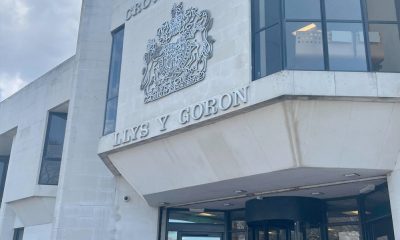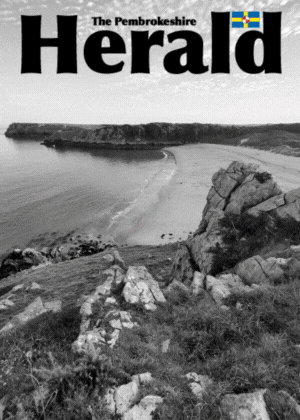News
Storms take toll on seabirds

 THE RECENT storms have taken its toll on a number of seabirds which are being washed up on Pembrokeshire beaches.
THE RECENT storms have taken its toll on a number of seabirds which are being washed up on Pembrokeshire beaches.
Following one of the stormiest winters on record, the Wildlife Trust of South and West Wales is reporting that wrecks of dead seabirds are now being recorded in Wales.
The Wildlife Trust, which manages the internationally important seabird islands of Skomer and Skokholm on the Pembrokeshire coast, says that following recent reports of wrecks on the English and French coasts, many are now also being reported from beaches like Newgale, Broad Haven and Ferryside.
Between them Skomer and Skokholm are home to over 20,000 puffins as well as around 28,000 guillemots and 9,000 razorbills, which makes up the most important colony of cliff nesting seabirds in southern Britain. There seems little doubt that many local birds are amongst the recent casualties at sea.
Skomer Wardens Ed Stubbings and Bee Büche visited Newgale beach on February 23 with local birders Anna and Steve Sutcliffe.
Ed Stubbings said: “We found around sixty dead seabirds, almost half were razorbills. Like wrecks of birds recorded elsewhere on the coast, many were clearly malnourished, and had suffered badly in the stormy conditions”.
This was confirmed by Pembrokeshire veterinary volunteer John Walmsley, whose post mortems clearly demonstrated the emaciated condition of the dead birds. Ed added: “One of the birds we found on the weekend had an individually marked ring on its leg which, when traced will reveal where the bird had come from. If anyone finds dead birds on the beach please look for metal rings and report the numbers to the British Trust for Ornithology (BTO)”.
Dr Lizzie Wilberforce, Conservation Manager with the Wildlife Trust, believes the unprecedented combination of threats facing our seabirds make them a priority for research. She said: “We are recording declines in breeding success of many colonies which we believe to be connected to climate change. Together with storm impacts and pollution events, we have reason to be very concerned for these iconic species.
“However, we are also seeing significant cuts to the funding that supports seabird research and monitoring, just when we need it most. Natural Resources Wales has withdrawn funding altogether from one forty year old programme of monitoring Skomer’s guillemots, led by the University of Sheffield, which generates absolutely critical data. The timing couldn’t be worse- we really need to understand how our birds are reacting to these threats if we are to be equipped to help them.”
Ed Stubbings went on to say: “We’re hoping to go back out to Skomer in the next couple of weeks in preparation for the coming season. We will be doing everything we can to assess the effects of recent events on our Pembrokeshire birds as the breeding season progresses, but we may not know the true impact for some months or even years.”
Please note if you find a dead bird with a metal ring on its leg please contact the B.T.O., if the bird has a geolocator attached to it please contact us.
Entertainment
What’s not to love about Prince Nathaniel of Neyland?

VAIN, enthusiastic, dramatic and utterly loveable, Prince Nathaniel of Neyland is set to steal hearts on the Torch Theatre stage this festive season in Rapunzel.
Played by the charismatic Harry Lynn, the flamboyant prince is the sort of pantomime hero audiences can’t help but cheer on, even when he is wildly out of his depth. From the moment he steps on stage, Prince Nathaniel is determined to help Rapunzel at every possible turn – even if bravery doesn’t always come naturally.
Describing the role as “wonderfully silly, enthusiastic, and a big-hearted comedic hero,” Harry says Prince Nathaniel is “the epitome of royal bravery,” striking his dramatic “Prince Pose” whenever the moment allows.
“But in reality, he’s often nervous, dramatic, and hilariously out of his depth,” Harry explained. “He’s pampered, easily flustered, and very vain about his hair – to the point where a haircut at Belinda’s salon becomes a full-on event. Beneath all the bravado, though, he’s loyal, caring, and absolutely determined to do the right thing, especially when Rapunzel needs him.”
Harry, who trained at the Royal Welsh College of Music and Drama, believes audiences will quickly fall for the prince’s perfectly imperfect charm.
“He’s confident but clueless, brave but squeamish, and always trying his best,” he said. “And when it really counts, he genuinely steps up. Whether he fully saves the day… well, this is a pantomime, so every hero needs a little help. Let’s just say he plays an integral part in Rapunzel’s fairytale ending.”
A familiar face to panto fans, Harry has just completed a run as Hunk/Scarecrow in The Wizard of Oz at Aberystwyth Arts Centre and says the festive season is his favourite time of year to perform.
“Panto season is pure joy – loud audiences, lots of laughter, plenty of improvisation, and that special festive atmosphere where anything can happen,” he said. “It’s a theatre experience like no other and the perfect way to celebrate Christmas.”
Prince Nathaniel, however, rarely has a quiet moment on stage. He is chased, sprayed, gunged, electrocuted, bashed in the face, tangled in a complicated ladder sequence – and faints, falls, panics, poses and hides behind Belinda whenever fear takes over.
“It’s a lot,” Harry laughed. “The challenge is keeping the comedy big and bold while still maintaining his charm. Having the Prince arrive in full regal mode, only to be sprayed in the face and gunged by Belinda, is peak panto chaos – huge fun to perform and, hopefully, even more fun to watch.”
Rapunzel – the hair-raising adventure runs at the Torch Theatre from Saturday, December 6 to Sunday, December 28. A Relaxed Environment performance takes place on Saturday, December 13 at 2:00pm, with a BSL-interpreted performance on Tuesday, December 16 at 6:00pm.
Tickets are priced at £24.50, £20.00 concessions, or £78.00 for a family ticket. For more information or to book, visit www.torchtheatre.co.uk or call the Box Office on (01646) 695267.
Crime
Cowboy builders jailed after years of bullying and fraud against homeowners

A FATHER and son who preyed on homeowners across south and west Wales — many of them elderly or in poor health — have been jailed after a court heard how they used intimidation and deception to extract huge sums of money for unnecessary and badly executed building work.
Jim Janes and his son, Thomas James, ran a long-running roofing scam that left dozens of victims facing financial hardship, unfinished homes and costly repair bills.
Swansea Crown Court heard the pair routinely targeted householders with minor repair needs before escalating jobs into major works, demanding ever-increasing payments once roofs had been stripped or damaged.
When questioned or challenged, the defendants became aggressive, leaving victims feeling frightened and pressured into paying. In one case, a homeowner was threatened unless money was handed over.
Passing sentence, Judge Catherine Richards said the defendants showed a “cruel disregard” for the impact of their actions and deliberately manipulated vulnerable people for financial gain.
She told the court the offending was driven by greed and a willingness to exploit those least able to protect themselves.
The court heard the fraud continued for more than five years, during which the defendants traded under multiple business names, changed contact details, and used different bank accounts in an effort to avoid detection.
Lee Reynolds, prosecuting, said the pair often dismantled roofs without consent and left properties exposed to the weather, effectively forcing customers to comply with their demands or face further damage to their homes.
Many victims were in their sixties, seventies and eighties, with some paying tens of thousands of pounds. One homeowner lost £100,000.
Independent experts later found that much of the additional work charged for was unnecessary and that the workmanship carried out was of poor quality. In some cases, jobs were left incomplete, requiring extensive remedial work.
Victims told the court how they had been left anxious, ashamed and financially stretched, with some forced to borrow money or remortgage their homes to cover the costs.
Jim Janes, 55, and Thomas Michael Jim James, 37, both of Llangadog, Carmarthenshire, had previously pleaded guilty to fraudulent trading.
In mitigation, the court heard Janes had worked in the building trade for much of his life, while James was said to have played a lesser role in the operation. However, the judge rejected claims that either man bore reduced responsibility.
Sentencing both men to eight years in prison, Judge Richards said they had acted ruthlessly and without any regard for the harm caused to their victims.
Both defendants will serve 40 per cent of their sentences in custody before being released on licence.
A further hearing will be held on Thursday (May 22) next year to consider confiscation proceedings and the imposition of serious crime prevention orders.
Crime
Cocaine dealers jailed after flooding Aberystwyth streets with drugs

TWO men who supplied cocaine in Aberystwyth have been jailed after police seized large amounts of cash, drugs and weapons during coordinated raids.
Luke Hutton, aged 25, and Lee Mark Walsh, 37, were sentenced at Swansea Crown Court after admitting possession of cocaine with intent to supply and possessing criminal property.
The court heard that police attended Walsh’s flat in Aberystwyth on Thursday (Nov 14) to execute a search warrant. Officers saw several people outside the address, including both defendants. When police approached, Walsh remained at the property while Hutton attempted to flee but was quickly detained.
Walsh, of Yr Hafan, Aberystwyth, was found with cannabis, £160 in cash and a mobile phone. Hutton, of Corporation Street, Aberystwyth, was carrying £8,795 in cash and a phone.
During a strip search in custody, officers recovered a wrap of white powder concealed on Hutton. Further searches uncovered £850 in cash laid out on Walsh’s bed, five mobile phones, a silver knuckleduster and a large kitchen knife hidden beneath the bed.
Police also recovered scales with white powder residue, a bank card contaminated with drug traces, and a further bag of white powder elsewhere in the flat. At Hutton’s address, officers found £1,060 in cash, bicarbonate of soda and empty snap-seal bags, consistent with drug preparation.
Prosecutor Dean Pulling told the court both men were clearly involved in drug supply for financial gain.
Walsh also admitted possession of an offensive weapon and possession of cannabis. He has previous convictions for cannabis offences and failing to comply with a drugs test.
Hutton has a longer record, including offences involving communications, driving matters, domestic abuse and breaching a restraining order.
Mitigating for Walsh, Ryan Bowen said the defendant had experienced a troubled childhood, moving schools frequently, and had struggled with cannabis use from a young age. He said Walsh had shown a strong work ethic and hoped to pursue barbering on release.
Jon Tarrant, representing Hutton, said his client had been heavily addicted to cocaine and that drug use had dominated his life, contributing to the breakdown of relationships, including contact with his two young children.
Sentencing, Judge Vanessa Francis said both men had been involved in dealing with the expectation of making “significant financial gain”.
Addressing Hutton, she said: “You told the author of the pre-sentence report that when your benefits stopped, you ‘did what you had to do’. This court will do what it has to do to take off the streets those who spread the misery of drug supply.”
After reductions for guilty pleas, Hutton was jailed for three years and Walsh for 32 months. Both will serve up to half of their sentences in custody before being released on licence.
-

 Crime4 days ago
Crime4 days agoMilford Haven man jailed after drunken attack on partner and police officers
-

 News7 days ago
News7 days agoDyfed-Powys Police launch major investigation after triple fatal crash
-

 Crime4 days ago
Crime4 days agoTeenager charged following rape allegation at Saundersfoot nightclub
-

 Crime5 days ago
Crime5 days agoMan charged with months of coercive control and assaults
-

 Crime5 days ago
Crime5 days agoMan sent to Crown Court over historic indecent assault allegations
-

 Crime5 days ago
Crime5 days agoMilford Haven man admits multiple offences after A477 incident
-

 Crime7 days ago
Crime7 days agoTrefin dog case ends in forfeiture order after protection notice breach
-

 Crime5 days ago
Crime5 days agoWoman ‘terrified in own home’ after ex breaches court order






















